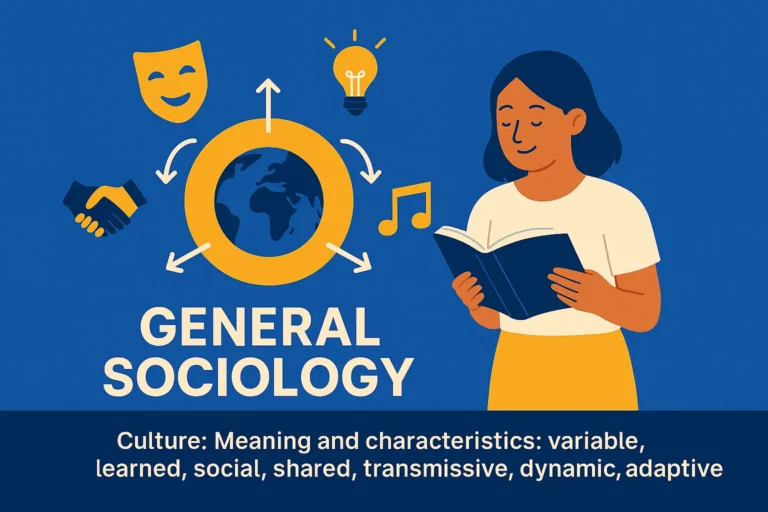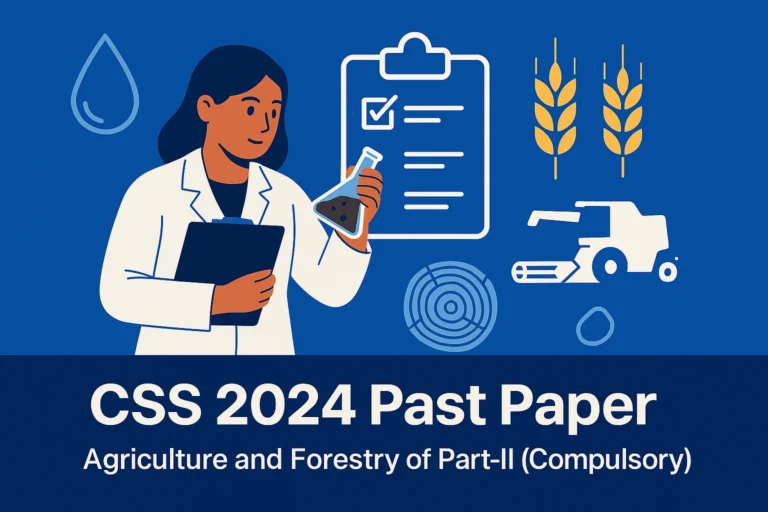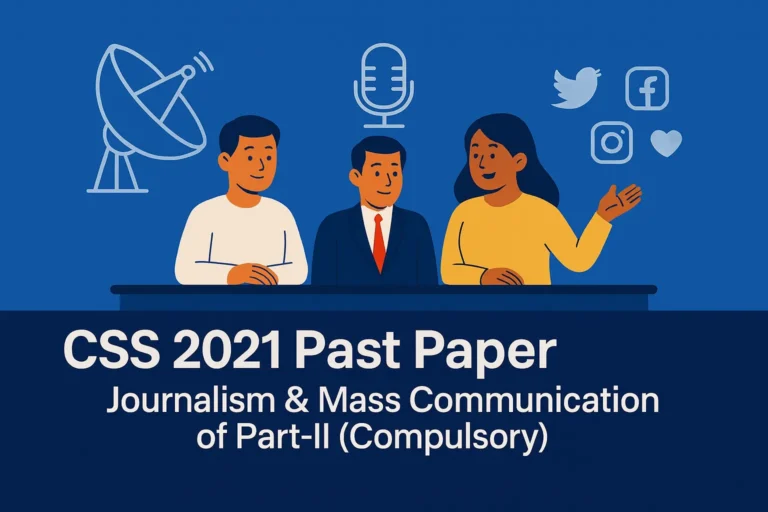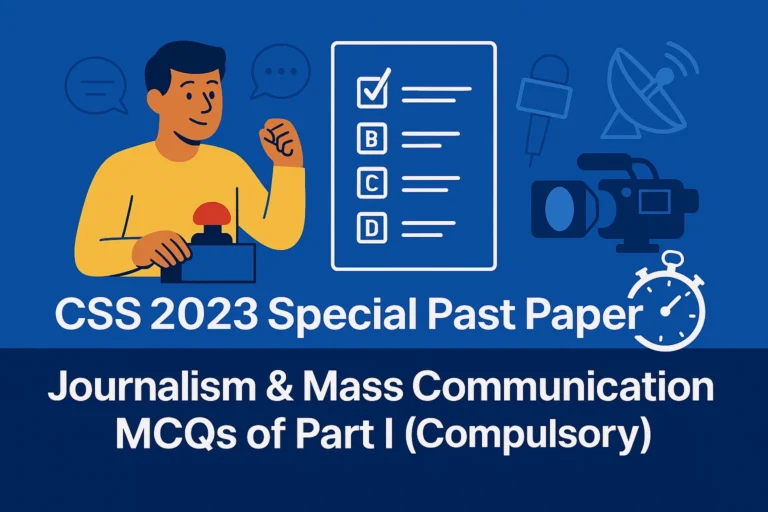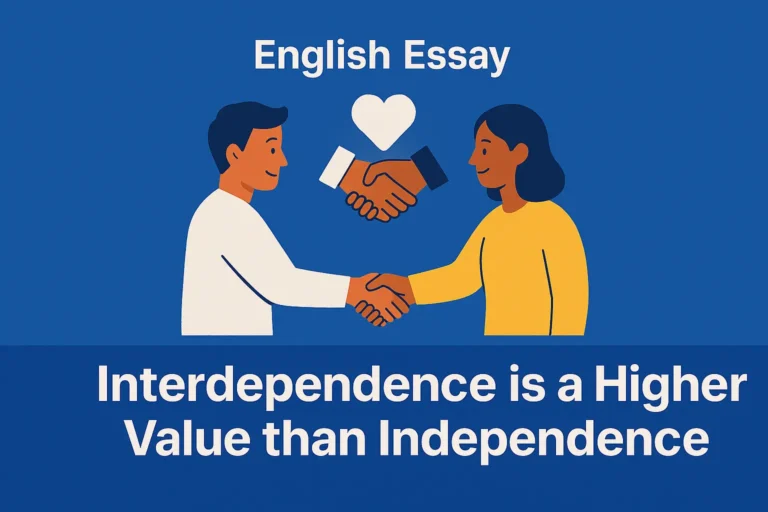CSS 2017 Solved Past Paper – Journalism & Mass Communication Part-II (Compulsory)
Below is the solution to PART-II (COMPULSORY) of the CSS 2017 Journalism & Mass Communication Paper.
Question 2
Briefly narrate the implications and shortcomings of the Shannon and Weaver model of Communication?
Introduction
The Shannon and Weaver model was made in 1948 by Claude Shannon and Warren Weaver. It was first used in telecommunication to explain how messages are sent and received. Later, it became one of the basic models to study communication in mass media and other fields.
Structure of the Model
It includes five main parts:
- Information Source – where the message comes from
- Transmitter – which sends the message into signals
- Channel – the medium through which the signal travels
- Receiver – which gets the signal and changes it back to a message
- Destination – the final user of the message
There is also a sixth part:
- Noise – any disturbance that affects the message during transmission.
Implications of the Model
- Foundation of Modern Communication Studies:
This model helped build the base of modern communication theory. Many future models were inspired by it. - Technical Understanding of Communication:
It helped understand how machines and people exchange information, especially in phone calls, radio, and TV. - Importance of Noise:
The idea of “noise” shows how messages can get disturbed or misunderstood, which is very important in real life communication. - Linear Flow of Message:
It explains that communication moves in a straight line — from sender to receiver — which helped simplify many complex ideas. - Useful in Mass Communication:
It is still used today to explain how mass media like newspapers, TV, and online platforms work to send messages to a large audience.
Shortcomings of the Model
- Linear and One-Way:
The model shows only one-way communication. It doesn’t show feedback or the response of the receiver, which is a big part of real communication. - Ignores Social and Cultural Context:
The model doesn’t explain how background, emotions, or culture affect the message and understanding between sender and receiver. - Too Mechanical:
It is more like a machine model. Human communication is not only about sending and receiving but also about feelings and understanding. - No Role of Feedback:
Feedback is important in communication, especially in personal or group settings. But the model doesn’t include it. - No Human Emotion Considered:
People don’t just send messages. They think, feel, and react. But Shannon and Weaver didn’t include this emotional side of communication.
Conclusion
Even though the Shannon and Weaver model is very basic and mechanical, it played an important role in the early development of communication theory. Its biggest strength is its clarity and simplicity. But in today’s time, it’s not enough alone because communication is not just technical — it’s also social, emotional, and interactive. So, we need to mix it with other modern models to fully understand how people communicate in real life.
Question 3
Explain how Uses and Gratification Theory is an audience centered approach in understanding Mass Communication. Also explain how is it positivistic approach?
Introduction
The Uses and Gratification Theory (UGT) is a famous theory in mass communication. It focuses on the audience rather than the message. The theory says that people use media to satisfy their own needs like information, entertainment, social connection, etc. It was developed in the 1940s–1970s, mainly by scholars like Elihu Katz, Jay Blumler, and Herbert Gurevitch.
Uses and Gratification as an Audience-Centered Approach
- Active Audience:
- The theory believes that audience is active, not passive. People choose what media they want to use.
- For example, some people watch news to stay informed, others use TikTok just for fun.
- Focus on Needs and Motives:
- It looks at why people use media — their personal needs, like:
- Cognitive needs – for knowledge/information
- Affective needs – for emotions/entertainment
- Personal identity – to find role models or values
- Social integration – to feel connected with others
- Tension release – to relax and escape
- It looks at why people use media — their personal needs, like:
- Choice and Control:
- People have full control over media usage. They decide what, when, and how to use media.
- This makes the audience the center of the communication process, not the media or sender.
- Media as Tool, Not Power:
- The media is just a tool used by the audience to fulfill needs. It is not powerful on its own unless the audience chooses to use it.
- Different Gratifications for Different People:
- Not everyone uses media for the same reason. Two people may watch the same drama, but one watches it for fun, and the other to learn about culture.
How It Is a Positivistic Approach
- Scientific Method:
- UGT uses scientific ways like surveys and questionnaires to find out how people use media.
- It collects real data from users and draws conclusions.
- Quantitative Research:
- The theory is based on numbers, statistics, and patterns. This is called a positivist way of research.
- Objective Observation:
- It tries to stay neutral. Researchers don’t put their own opinion. They just observe what users say and how they behave.
- Focus on Behavior:
- It studies the behavior of users, which is a major point of positivism — watching and measuring what people actually do.
- Theory Testing:
- UGT can be tested again and again with new audiences, which is another sign of a positivist theory.
Criticism of UGT
- Sometimes people don’t know why they use media, so their answers may be unclear.
- It focuses too much on the individual and ignores social influence like culture or family.
- It assumes audience is always rational, which is not always true.
Conclusion
The Uses and Gratification Theory is a unique and useful way to understand media. It puts the audience at the center, which is different from other older theories that saw audience as passive. Also, it uses a positivist method by doing real research and collecting data. Today, when people have many media options, this theory helps explain why and how they choose certain media.
Question 4
How Mac Bride Commission report analyze communication problems in modern societies? Discuss its recommendations in detail.
Introduction
The MacBride Commission was formed by UNESCO in 1977 to study communication problems in the world. It was led by Sean MacBride, a Nobel Peace Prize winner. The final report was published in 1980 with the title “Many Voices, One World.” It focused on how media and communication systems were unbalanced, especially between developed and developing countries.
Communication Problems in Modern Societies (According to the Report)
- Information Flow Imbalance:
- Rich countries control global media, while poor countries depend on their news and content.
- Western news agencies like Reuters, AP, AFP dominate world news.
- Media Imperialism:
- Western countries export their values and culture through media.
- This can destroy local cultures and traditions in weaker countries.
- Lack of Access:
- In developing countries, many people don’t have access to media or communication tools.
- Illiteracy and poverty make it harder to enjoy media benefits.
- Ownership Concentration:
- Few big companies own most of the media.
- This limits freedom of speech and variety in content.
- Propaganda and Political Use:
- Media is sometimes used by powerful groups for propaganda or to support their own agendas.
- Public is misled by false or biased information.
- Technology Gap:
- Rich countries have advanced communication technology.
- Poor nations cannot keep up, so the gap keeps growing.
Main Recommendations of the MacBride Report
- New World Information and Communication Order (NWICO):
- A fair and balanced system where every country gets equal opportunity to share and receive information.
- Support for Local Media:
- Promote local languages and cultures through local radio, TV, and newspapers.
- Reduce dependence on foreign content.
- Free and Responsible Press:
- Press should be free but also follow ethics and responsibility.
- Freedom should not be used to spread hate or lies.
- Access to Communication for All:
- Everyone, especially in rural and poor areas, should get access to media.
- Governments should invest in communication infrastructure.
- Training and Education:
- Train journalists and media workers in developing countries.
- Media education should be part of school systems.
- Reduce Monopoly:
- Stop few companies from controlling all media.
- Support independent and community media.
- Global Cooperation:
- Countries should work together in technology sharing, media exchange programs, and fair use of satellites and communication channels.
- Right to Communicate:
- All people should have the basic right to express, receive, and share ideas.
Impact of the Report
- The report started many global debates on media fairness.
- Some western countries, especially USA and UK, opposed it. They feared it would affect their media power.
- Even though NWICO was not fully applied, it made people aware about global media imbalance.
- The ideas still influence media policy, communication rights, and UNESCO programs today.
Conclusion
The MacBride Commission Report was an important step toward fair communication in the world. It clearly pointed out the problems like imbalance, control by rich nations, and lack of access. Its recommendations were focused on building a more equal and ethical media system. Even though not all suggestions were accepted, the report is still very important in media history and is often used in communication studies.
Question 5
Define Public Relations. Also explain its tools and techniques and challenges in Pakistan.
Introduction
Public Relations (PR) is a strategic communication process that builds a positive image between an organization and its publics. It is about managing how people see and think about a person, company, or government. PR is not just about media, it is also about trust, reputation, and good communication.
Definition
According to Institute of Public Relations,
“PR is the planned and sustained effort to establish and maintain mutual understanding between an organization and its public”.
So, PR is basically about making good relations with the people who are important to the organization.
Main Objectives of Public Relations
- Create a positive image of the organization
- Build trust and understanding with the public
- Handle crises and avoid bad reputation
- Promote ideas, services, or policies
- Support marketing and branding indirectly
Tools and Techniques of Public Relations
PR uses many different tools to reach its goals. Some of the main ones are:
1. Press Releases:
- Official statements sent to media to announce something important (e.g. launching a product or an event).
2. Press Conferences:
- A live meeting with journalists where the organization shares information and answers questions.
3. Social Media:
- Platforms like Twitter, Facebook, Instagram are now used for PR. Fast and direct communication with the public.
4. Media Relations:
- Building a good relationship with journalists so that they cover your news in a positive way.
5. Events and Sponsorships:
- Organizing or sponsoring events like sports, seminars, or cultural shows to promote brand image.
6. Internal Communication:
- Communicating with employees through newsletters or meetings to keep them motivated and informed.
7. Corporate Social Responsibility (CSR):
- Doing charity, social work, or environmental actions to improve image of the company.
8. Crisis Management:
- When something goes wrong (like a scandal or accident), PR helps to fix the image quickly.
Challenges of Public Relations in Pakistan
Even though PR is growing in Pakistan, it still faces many problems:
1. Lack of Awareness:
- Many organizations, especially in public sector, don’t understand what PR really is.
- They think it’s only about giving ads or calling media.
2. Poor Training:
- There are not enough professional PR experts.
- Many PR officers are not trained in modern PR strategies.
3. Political Influence:
- In government departments, PR is often used for political gain, not real public communication.
4. Fake News and Misinformation:
- Social media has made it easy for false news to spread.
- PR teams have to work extra hard to manage this.
5. Media Corruption:
- Some media outlets expect bribes or gifts in exchange for good coverage.
- This affects fair PR practices.
6. Limited Use of Digital PR:
- In many areas, especially rural, digital tools like websites and social media are not used properly.
7. Trust Deficit:
- People don’t always trust official statements, especially from the government. This makes PR work harder to win public trust.
Conclusion
Public Relations is a powerful tool in today’s communication world. It helps in building trust, managing reputation, and engaging with the public in a positive way. In Pakistan, PR is developing slowly, but still has many challenges to overcome. With professional training, modern tools, and ethical practices, PR can become a strong part of both government and private sectors in the country.
Question 6
Define and explain the term Development Support Communication. Also narrate how it can be helpful in solving various social issues of Pakistani society?
Introduction
Communication is a key tool in developing countries like Pakistan. When communication is used to support national development goals, it is called Development Support Communication (DSC). It helps in spreading awareness, educating people, and solving social problems through media and other communication methods.
Definition of Development Support Communication
According to UNESCO,
“DSC is the planned use of communication techniques, media, and messages to support development programs”.
In simple words, it means using communication to help people improve their lives by giving them useful knowledge and encouraging them to act.
Key Features of Development Support Communication
- Two-Way Communication:
- It is not just about sending messages but also listening to people.
- Focus on Social Development:
- DSC talks about health, education, agriculture, environment, women rights, etc.
- Use of All Media:
- It uses radio, TV, newspapers, posters, theatre, and social media to reach different people.
- Targeted Audience:
- Messages are made for specific groups, like farmers, women, or students.
- Behavior Change:
- The main goal is to change people’s behavior in a positive way.
Role of DSC in Solving Social Issues in Pakistan
Pakistan faces many social issues like poverty, illiteracy, health problems, extremism, and gender inequality. DSC can help solve these issues in the following ways:
1. Education Awareness:
- Through radio programs and TV shows, DSC can promote the importance of education.
- Especially useful in rural areas where literacy is low.
2. Health Campaigns:
- DSC can spread awareness about polio, dengue, hepatitis, COVID-19, etc.
- For example, the “Sehat Muhafiz” polio campaign used DSC effectively.
3. Women Empowerment:
- Communication can change the mindset of society by showing positive role models of women.
- Can promote messages against early marriage, domestic violence, and support for girls’ education.
4. Population Control:
- DSC can educate people about family planning through dramas, ads, and mobile messages.
5. Agriculture Development:
- Farmers can learn new techniques through radio shows or mobile apps.
- Weather forecasts and market rates can be shared easily.
6. Environment Protection:
- Media can educate people about climate change, tree plantation, clean water, and waste management.
7. Fighting Extremism:
- Positive messaging can reduce radical thinking.
- DSC promotes peace, tolerance, and unity through campaigns and social influencers.
8. Voter Education and Civic Rights:
- Helps citizens understand their rights and responsibilities.
- Encourages voting, participation, and democracy.
Examples of DSC Projects in Pakistan
- Punjab Health Line (1033) for mother-child health education.
- Television shows like “Aangan” and “Udaari” promoted child rights and women safety.
- Radio Pakistan broadcasts rural development content in local languages.
- Social media campaigns by NGOs like Aurat Foundation, PPAF, and UNICEF Pakistan.
Conclusion
Development Support Communication is an effective tool for solving Pakistan’s social problems. When used wisely, it can bring awareness, change public behavior, and support government and NGO efforts. By using modern technology and local languages, DSC can reach the most backward areas of Pakistan and bring real development.
Question 7
“Pakistani media organizations are unable to formulate a self-disciplined code of ethics”. Do you agree or not. Support your answer with logic and arguments.
Introduction
Media plays a very important role in shaping society. But with this power comes the responsibility to follow certain ethical rules. A code of ethics helps media organizations maintain truth, fairness, and responsibility. In Pakistan, many people believe that media lacks self-discipline, and there is no proper ethical control.
In my opinion, yes, I agree that most media organizations in Pakistan have failed to create and follow a proper, self-disciplined code of ethics.
Arguments in Support (Why they are unable to do it)
1. Race for Ratings (TRPs):
- Media channels focus more on getting views than spreading truth.
- They often sensationalize news to get attention, even if it’s against journalistic ethics.
2. Lack of Internal Accountability:
- Many media houses don’t punish or stop unethical practices done by their own journalists or anchors.
- There is no proper internal check system.
3. Political and Corporate Pressure:
- Media is often used as a tool by political parties or big businesses.
- News is twisted to benefit certain groups, which kills neutral reporting.
4. Paid Content and Fake News:
- Some channels take money to run stories or ignore certain news.
- False reporting has increased, especially on social media.
5. Weak Regulatory Bodies:
- PEMRA and other authorities have limited power or are sometimes used politically.
- There is no strong law enforcement for ethical rules.
6. Lack of Training:
- Many journalists are not properly trained in ethics or responsible reporting.
- They don’t know the difference between freedom of speech and spreading hate or lies.
7. Absence of a Unified Code:
- Pakistan has many media houses, but no one shared code of ethics that all follow.
- Without unity, it’s hard to create a self-disciplined system.
Examples of Unethical Media Practices in Pakistan
- Irresponsible coverage of terrorist attacks, showing blood and chaos on screen.
- Invasion of privacy in celebrity or political scandals.
- Biased political talk shows, with anchors showing clear support for one party.
- Spreading fake news on social media without checking facts.
Counter-Argument (Some improvements do exist)
- Some media houses have started ethics departments.
- PFUJ (Pakistan Federal Union of Journalists) and CPNE are working to improve media standards.
- Public awareness has increased due to social media criticism.
But still, the overall media scene lacks a strong self-controlled ethical system.
Recommendations for Improvement
- Unified Code of Ethics:
All media houses must agree on a standard set of rules. - Stronger Role of PEMRA and PFUJ:
These organizations should be independent and powerful enough to punish unethical acts. - Media Education:
Journalists and anchors must be trained regularly in ethical reporting. - Audience Responsibility:
Viewers must also demand quality and truth, not just drama. - Encourage Investigative Journalism:
Promote real journalism instead of talk shows full of shouting and fights.
Conclusion
To sum up, most media organizations in Pakistan have not succeeded in forming a self-disciplined code of ethics. Personal gain, lack of unity, political pressure, and poor accountability are the main reasons. If media wants to play a positive role in society, it must become more responsible, united, and ethical. Otherwise, public trust will continue to fall.
Question 8
Write brief notes on any TWO of the following:
a. Media as an agent of social change
b. Gerbner’s Model of Communication
c. Role of Social media in Pakistan
a. Media as an Agent of Social Change
Introduction
Media is one of the most powerful tools in modern society. It not only informs and entertains but also shapes people’s thinking, changes values, and pushes for development. That’s why media is called an agent of social change.
How Media Brings Social Change?
1. Awareness and Education:
- Media spreads knowledge about health, education, human rights, and laws.
- Campaigns like polio awareness, women rights, or anti-drug programs are run through media.
2. Breaking Social Taboos:
- TV dramas and talk shows discuss issues like domestic violence, mental health, or child abuse.
- These topics were once hidden but now people talk about them.
3. Promoting Gender Equality:
- Media shows strong female characters and successful women in leadership.
- It helps change old thinking about women’s roles.
4. Political Awareness:
- News channels and political shows help people understand democracy and elections.
- Citizens become more active and aware of their rights.
5. Highlighting Injustices:
- Media exposes corruption, abuse of power, and social injustice.
- This pressures authorities to take action.
6. Creating National Unity:
- In difficult times like floods, earthquakes, or during Independence Day, media plays a role in uniting the nation.
Examples from Pakistan
- “Udaari” drama raised awareness on child abuse.
- Social campaigns for girls’ education in rural areas.
- Media coverage of incidents like Zainab case pushed the government to act on child safety laws.
Conclusion
Media has a huge power to influence minds and change societies. If used responsibly, it can bring positive change, but if misused, it can also spread hate or false ideas. So, media must act with ethics and responsibility to truly help society grow.
b. Gerbner’s Model of Communication
Introduction
George Gerbner was a communication theorist who gave a model in 1956 to explain how communication works, especially in mass media. His model shows that communication is a complex and continuous process that involves sharing messages, meaning, and context.
Main Idea of the Model
Gerbner believed that communication is more than just sending and receiving messages. It also includes how we interpret the message and how the message is shaped by different factors like culture, experience, and media.
Key Components of the Model
- E (Event):
Something happens in the real world — an event or message source. - M (Perceiver):
A person observes or experiences the event. - SE (Signal or Message):
The form in which the event is shown or communicated (like news, video, or article). - Means and Controls:
The media or tools used to send the message, and the people who control them (like editors or producers). - Channels and Contexts:
How the message is sent and the environment in which it is received. This affects understanding.
How It Works?
- First, an event happens (E).
- Someone (M) notices and describes it.
- A message (SE) is created and shared through a medium (TV, newspaper, etc.).
- The audience sees it and makes their own meaning.
Example
A bomb blast happens (E).
A reporter (M) sees it and writes a news report (SE).
The story is shown on TV (medium).
Viewers watch it and react in their own way.
Importance of Gerbner’s Model
- It includes both message creation and interpretation.
- It shows that media messages are not always the same as real events.
- Helps understand how media shapes our view of reality.
Criticism
- The model can be a bit complex to understand.
- It focuses more on media communication and less on personal communication.
- Doesn’t clearly explain feedback.
Conclusion
Gerbner’s model is useful for understanding how media messages are created and received. It shows that communication is not just about sending facts — it’s about how events are shown and how people understand them. This model is very helpful in studying mass media communication.
c. Role of Social Media in Pakistan
Introduction
Social media has become a major part of life in Pakistan. Platforms like Facebook, Twitter, Instagram, YouTube, and TikTok are used by millions. It has changed the way people communicate, get news, and express their opinions.
Positive Roles of Social Media
1. Fast News and Information:
- News spreads quickly on social media, even faster than TV sometimes.
- Citizens also report local events using mobile phones.
2. Freedom of Expression:
- People now share their views freely, especially the youth.
- Many sensitive issues are discussed online which were ignored before.
3. Political Participation:
- Political parties use social media for campaigns and live sessions.
- Voters follow leaders and stay informed.
4. Awareness Campaigns:
- NGOs and social activists use social media to run campaigns on health, education, women rights, etc.
- Hashtags like #JusticeForZainab, #SayNoToCorruption, etc. went viral.
5. Business and Jobs:
- Many people use social media for online businesses, freelancing, and marketing.
- It has created new job opportunities in Pakistan.
Negative Aspects
1. Fake News and Misinformation:
- Many fake accounts spread false or misleading news.
- People sometimes believe it without checking.
2. Cyberbullying and Harassment:
- Especially women face online abuse and threats.
3. Political Polarization:
- Political parties and supporters fight and insult each other on platforms like Twitter.
4. Waste of Time:
- Many youths spend hours scrolling TikTok or Instagram without any benefit.
Conclusion
Social media has become a double-edged sword in Pakistan. It brings freedom, awareness, and economic benefits, but also challenges like fake news and hate speech. The key is to use it responsibly. With digital literacy and law enforcement, social media can become a positive force for Pakistan’s progress.

